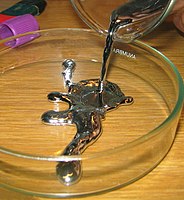
Photo from wikipedia
Semiconductor photocatalysis technology has shown great potential in the field of organic pollutant removal, as it can use clean and pollution-free solar energy as driving force. The discovery of silver… Click to show full abstract
Semiconductor photocatalysis technology has shown great potential in the field of organic pollutant removal, as it can use clean and pollution-free solar energy as driving force. The discovery of silver phosphate (Ag3PO4) is a major breakthrough in the field of visible light responsive semiconductor photocatalysis due to its robust capacity to absorb visible light < 520 nm. Furthermore, the holes produced in Ag3PO4 under light excitation possess a strong oxidation ability. However, the strong oxidation activity of Ag3PO4 is only achieved in the presence of electron sacrifice agents. Otherwise, photocorrosion would greatly reduce the reuse efficiency of Ag3PO4. This review thus focuses on the structural characteristics and preparation methods of Ag3PO4. Particularly, the recent advances in noble metal deposition, ion doping, and semiconductor coupling, as well as methods of magnetic composite modification for the improvement of catalytic activity and recycling efficiency of Ag3PO4-based catalysts, were also discussed, and all of these measures could enhance the catalytic performance of Ag3PO4 toward organic pollutants degradation. Additionally, some potential modification methods for Ag3PO4 were also proposed. This review thus provides insights into the advantages and disadvantages of the application of Ag3PO4 in the field of photocatalysis, clarifies the photocorrosion essence of Ag3PO4, and reveals the means to improve photocatalytic activity and stability of Ag3PO4. Furthermore, it provides a theoretical and methodological basis for studying Ag3PO4-based photocatalyst and also compiles valuable information regarding the photocatalytic treatment of organic polluted wastewater.
Journal Title: Environmental Science and Pollution Research
Year Published: 2022
Link to full text (if available)
Share on Social Media: Sign Up to like & get
recommendations!